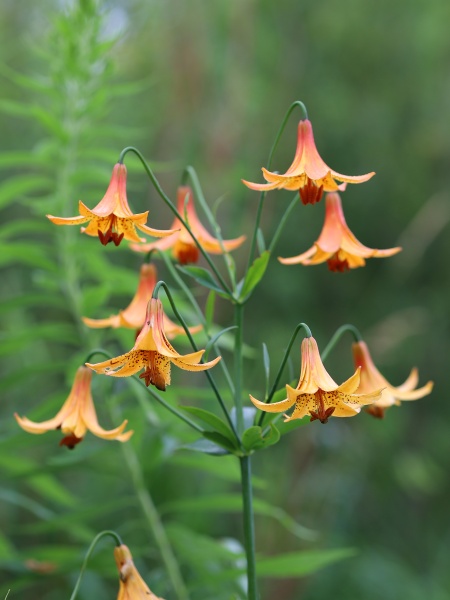 Known to be toxic - Toxic! Fatal to cats.
Known to be toxic - Toxic! Fatal to cats.

Source: Nichole Ouellette
Lilium canadense
Canada Lily
Lis du Canada
No seeds available for this plant.
We currently accept seeds for this plant
Bloom Colour: Orange
Bloom Period: Jun - Aug
Max Height: 8.0 feet
Max Width: 3.0 feet (spreads by rhizome)
Light Condition:
 More than 6 hours of direct sun a day
More than 6 hours of direct sun a day
 More than 2 or 3 hours but less than 6 hours of direct sun a day
Soil conditions:
More than 2 or 3 hours but less than 6 hours of direct sun a day
Soil conditions:
 Tolerates medium soil condition
Tolerates medium soil condition
 More than 6 hours of direct sun a day
More than 6 hours of direct sun a day
 More than 2 or 3 hours but less than 6 hours of direct sun a day
More than 2 or 3 hours but less than 6 hours of direct sun a day
 Tolerates medium soil condition
Tolerates medium soil condition
Lifespan:
Perennial
plants that will that come back year after year
Gardener Experience:
 Does not spread uncontrollably
Does not spread uncontrollably
 Does not spread uncontrollably
Does not spread uncontrollably
Landscape Uses:
 Suitable for wetland garden
Suitable for wetland garden
 Suitable for school gardens
Suitable for school gardens
 Suitable for wetland garden
Suitable for wetland garden
 Suitable for school gardens
Suitable for school gardens
Ecological Benefits:
No ecological benefits information available.
Tolerates:
 Tolerates juglone conditions
Tolerates juglone conditions
 Tolerates transplantation
Tolerates transplantation
 Tolerates juglone conditions
Tolerates juglone conditions
 Tolerates transplantation
Tolerates transplantation
Special Features and Considerations:
 This plant is endangered
This plant is endangered
 This plant causes skin rashes
This plant causes skin rashes
 This plant is endangered
This plant is endangered
 This plant causes skin rashes
This plant causes skin rashes
Plant Location
Distribution according to VASCAN

Ephemeral
Native
Introduced
Excluded
Extirpated
Doubtful
Absent
Thrives in Ecozones
- Atlantic Maritime
- Boreal Shield
- Mixed Wood Plains
Ecological Benefits
Butterflies Supported by Lilium canadense
No butterfly data available for this plant.
Specialized Bees Supported by Lilium canadense
No bee data available for this plant.
Plants that grow in similar conditions, that bloom at the same time.
Complementary Plants
- Agastache nepetoides
Yellow Giant Hyssop
Agastache faux-népéta - Eupatorium perfoliatum
Common Boneset
Eupatoire perfoliée - Eutrochium maculatum
Spotted Joe Pye Weed
Eupatoire maculée - Scirpus atrovirens
Dark-green Bulrush
Scirpe noirâtre - Verbena hastata
Blue Vervain
Verveine hastée
Substitute For Non-Native Plants
- Iris pseudacorus (Yellow Iris)
- Iris (Iris Cultivars)
- Hyacinthus (Non-Native Hyacynth)
- Campanula (Non-native Bellflower)
- Petunia (Non-Native Petunias)
- Myosotis sylvatica (Forget-me-not)
- Lamprocapnos spectabilis (Bleeding hearts)
- Phlox subulata (Moss Phlox)
- Acer japonicum (Japanese Maple)
- Acer platanoides (Norway Maple)
- Lamium galeobdolon (Yellow Archangel)
- Buxus sempervirens (Boxwood)
- Forsythieae (Forsythia)
- Cirsium arvense (Canada Thistle)
- Clematis (Non-native Clematis)
- Lonicera).1 (Non-Native Honeysuckle)
- Hedera helix (English Ivy)
- Ipomoea (Morning Glories)
- Glechoma hederacea (Creeping Charlie)
- NA (Coreopsis cultivars)
- Hemerocallis (Daylily)
- Gaillardia (Blanket Flower)
- Elaeagnus angustifolia (Russian Olive)
- Elaeagnus umbellata (Autumn Olive)
- Anethum graveolens (Dill)
- Petroselinum crispum (Parsley)
- Diervilla (Non-Native Honeysuckle)
- Lonicera japonica (Japanese Honesuckle Vine)
- Impatiens glandulifera (Himalayan Balsam)
- Thalictrum (Non-Native Meadow Rue)
- Potentilla (Non-Native Potentilla)
- Leucanthemum (Shasta Daisy)
- Gerbera (Gerbera Daisy)
- NA (Non-native False Sunflower)
- Symphiotrichum (Non-Native Aster)
- Baptisia (False Indigo)
- Cotnius (Smokebush)
- Hibiscus (Non-Native Hibiscus)
- Astilbe (Astilbe)
- Impatiens balsamina (Impatiens Balsamina)
- Pachysandra terminalis).1 (Japanese Pachysandra)
- Berberis (Barberry)
- Canna (Lily)
- Juglans nigra (Black Walnut Cultivar)
- Chamaecyparis (False Cypress)
- Juniperus (Juniper Cultivar)
- Melilotus albus (Sweet White Clover)
- Lavandula (Lavender)
- Hesperis matronalis (Dame Rocket)
- Liatris (Blazing Star Cultivar)
Sowing Information
Download Seed Envelope Labels (PDF)
- Sowing depth: Sow just below surface
- Sow anytime
- Stratification duration: 150 days
- Notes: Warm moist stratify 60d, then cold moist stratify 90d.
Harvesting and Seed Sharing
- Harvest start month: August
- Harvesting indicator:
- Pods are slightly open and seeds inside are dark
- Harvesting:
- Open the pod, remove seeds
- Seed viability test:
- Put seed in front of light, if you can clearly see that the middle is opaque, you can donate. If the middle is translucent, do not donate
- Packaging measure: 1 rounded 1/32 teaspoon
- Seed storage:
- Air dry in paper bag or open container, for a few days until crisp
- Shake seeds to move them once in a while to prevent molding
- Cultivar: Yes, do not donate unless you know source, and there are no known cultivars in your garden or at proximity
- Remove non-seed material
- No harvesting video available at this time.
Toxicity Notes
Toxic! Fatal to cats.


 Canadensis
Canadensis
